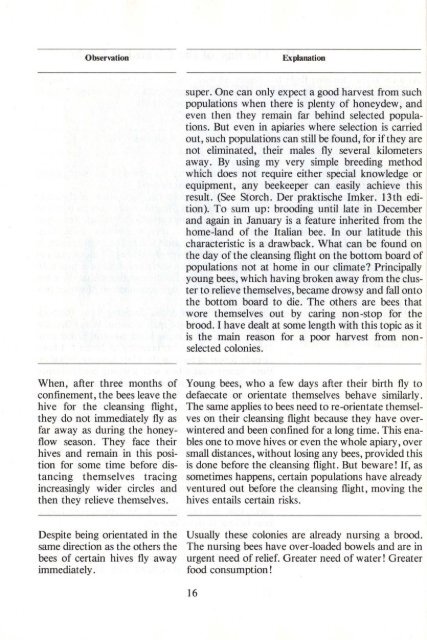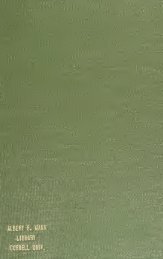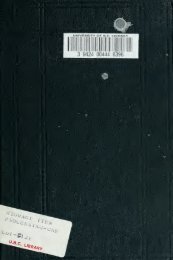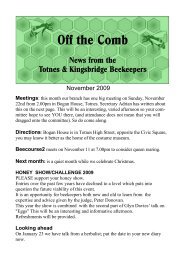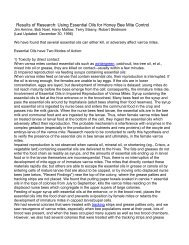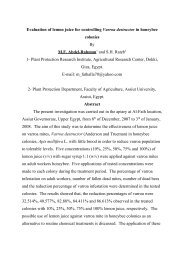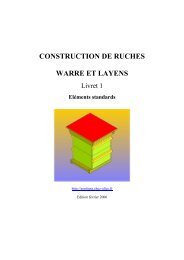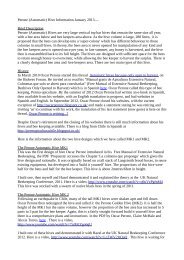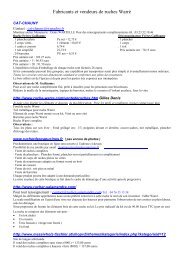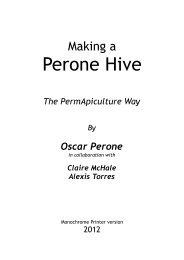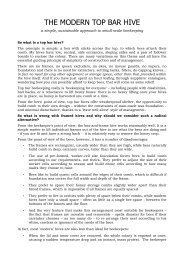Create successful ePaper yourself
Turn your PDF publications into a flip-book with our unique Google optimized e-Paper software.
Observation<br />
Explanation<br />
super. One can only expect a good harvest from such<br />
populations when <strong>the</strong>re is plenty of honeydew, and<br />
even <strong>the</strong>n <strong>the</strong>y remain far behind selected populations.<br />
But even in apiaries where selection is carried<br />
out, such populations can still be found, for if<strong>the</strong>y are<br />
not eliminated, <strong>the</strong>ir males fly several kilometers<br />
away. By using my very simple breeding method<br />
which does not require ei<strong>the</strong>r special knowledge or<br />
equipment, any beekeeper can easily achieve this<br />
result. (See Storch. Der praktische Imker. 13th edition).<br />
To sum up: brooding until late in December<br />
and again in January is a feature inherited from <strong>the</strong><br />
home-land of <strong>the</strong> Italian bee. In our latitude this<br />
characteristic is a drawback. What can be found on<br />
<strong>the</strong> day of <strong>the</strong> cleansing flight on <strong>the</strong> bottom board of<br />
populations not at home in our climate? Principally<br />
young bees, which having broken away from <strong>the</strong> cluster<br />
to relieve <strong>the</strong>mselves, became drowsy and fall onto<br />
<strong>the</strong> bottom board to die. The o<strong>the</strong>rs are bees that<br />
wore <strong>the</strong>mselves out by caring non -stop for <strong>the</strong><br />
brood. I have dealt at some length with this topic as it<br />
is <strong>the</strong> main reason for a poor harvest from nonselected<br />
colonies.<br />
When, after three months of<br />
confinement, <strong>the</strong> bees leave <strong>the</strong><br />
hive for <strong>the</strong> cleansing flight,<br />
<strong>the</strong>y do not immediately fly as<br />
far away as during <strong>the</strong> honeyflow<br />
season. They face <strong>the</strong>ir<br />
hives and remain in this position<br />
for some time before distancing<br />
<strong>the</strong>mselves tracing<br />
increasingly wider circles and<br />
<strong>the</strong>n <strong>the</strong>y relieve <strong>the</strong>mselves.<br />
Young bees, who a few days after <strong>the</strong>ir birth fly to<br />
defaecate or orientate <strong>the</strong>mselves behave similarly.<br />
The same applies to bees need to re-orientate <strong>the</strong>mselves<br />
on <strong>the</strong>ir cleansing flight because <strong>the</strong>y have overwintered<br />
and been confined for a long time. This enables<br />
one to move hives or even <strong>the</strong> whole apiary, over<br />
small distances, without losing any bees, provided this<br />
is done before <strong>the</strong> cleansing flight. But beware! If, as<br />
sometimes happens, certain populations have already<br />
ventured out before <strong>the</strong> cleansing flight, moving <strong>the</strong><br />
hives entails certain risks.<br />
Despite being orientated in <strong>the</strong><br />
same direction as <strong>the</strong> o<strong>the</strong>rs <strong>the</strong><br />
bees of certain hives flyaway<br />
immediately.<br />
Usually <strong>the</strong>se colonies are already nursing a brood.<br />
The nursing bees have over-loaded bowels and are in<br />
urgent need of relief. Greater need of water! Greater<br />
food consumption!<br />
16


